By Anthony Burgess
From the cover. A CLOCKWORK ORANGE_-Anthony Burgess' most famous novel-is a book of stunning force, the most cogent and terrifying vision of the future since George Orwell's 1984. Adrift in the impersonal, iron-gray society of the superstate, the novel's main character, 15-year-old Alex, leads his gang of teen-age rockers in all-night orgies of random violence and destruction. Told in a slang as electric as the events described, this is Alex's storyo f rapes and stompings and rumbles with the police, of prison life and the frightful "Ludovico Technique" by which Alex is "recon ditioned" into a model citizen, and of his subsequent adventures as a mindless pawn in the cynical hands of the authorities. "A brilliant novel . . . a tour de force in nastiness, an inventive primer in total violence, a savage satire o n t h edistortions o fthe single and collective minds."-New York Times.
NY. W.W. Norton. 1962. 184p.





















